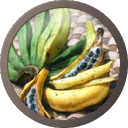Transcriptomic analysis of resistant and susceptible banana corms in response to infection by Fusarium oxysporum f. sp. cubense tropical race 4.
Summary
| Abstract | Fusarium wilt disease, caused by Fusarium oxysporum f. sp. cubense, especially by tropical race 4 (Foc TR4), is threatening the global banana industry. Musa acuminata Pahang, a wild diploid banana that displays strong resistance to Foc TR4, holds great potential to understand the underlying resistance mechanisms. Microscopic examination reports that, in a wounding inoculation system, the Foc TR4 infection processes in roots of Pahang (resistant) and a triploid cultivar Brazilian (susceptible) were similar by 7 days post inoculation (dpi), but significant differences were observed in corms of both genotypes at 14 dpi. We compare transcriptomic responses in the corms of Pahang and Brazilian, and show that Pahang exhibited constitutive defense responses before Foc TR4 infection and inducible defense responses prior to Brazilian at the initial Foc TR4 infection stage. Most key enzymatic genes in the phenylalanine metabolism pathway were up-regulated in Brazilian, suggesting that lignin and phytotoxin may be triggered during later stages of Foc TR4 infection. This study unravels a few potential resistance candidate genes whose expression patterns were assessed by RT-qPCR assay and improves our understanding the defense mechanisms of Pahang response to Foc TR4. | ||
|---|---|---|---|
| Publication Date | 3 June 2019 | ||
| DOI | 10.1038/s41598-019-44637-x | ||
| Cross Reference |
| ||
| Citation | Zhang L, Cenci A, Rouard M, Zhang D, Wang Y, Tang W, Zheng SJ. Transcriptomic analysis of resistant and susceptible banana corms in response to infection by Fusarium oxysporum f. sp. cubense tropical race 4.. Scientific reports. 2019 06 03; 9(1):8199. |





